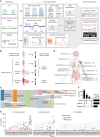Early Cancer Detection in Li-Fraumeni Syndrome with Cell-Free DNA
- PMID: 37874259
- PMCID: PMC10784744
- DOI: 10.1158/2159-8290.CD-23-0456
Early Cancer Detection in Li-Fraumeni Syndrome with Cell-Free DNA
Abstract
People with Li-Fraumeni syndrome (LFS) harbor a germline pathogenic variant in the TP53 tumor suppressor gene, face a near 100% lifetime risk of cancer, and routinely undergo intensive surveillance protocols. Liquid biopsy has become an attractive tool for a range of clinical applications, including early cancer detection. Here, we provide a proof-of-principle for a multimodal liquid biopsy assay that integrates a targeted gene panel, shallow whole-genome, and cell-free methylated DNA immunoprecipitation sequencing for the early detection of cancer in a longitudinal cohort of 89 LFS patients. Multimodal analysis increased our detection rate in patients with an active cancer diagnosis over uni-modal analysis and was able to detect cancer-associated signal(s) in carriers prior to diagnosis with conventional screening (positive predictive value = 67.6%, negative predictive value = 96.5%). Although adoption of liquid biopsy into current surveillance will require further clinical validation, this study provides a framework for individuals with LFS.
Significance: By utilizing an integrated cell-free DNA approach, liquid biopsy shows earlier detection of cancer in patients with LFS compared with current clinical surveillance methods such as imaging. Liquid biopsy provides improved accessibility and sensitivity, complementing current clinical surveillance methods to provide better care for these patients. See related commentary by Latham et al., p. 23. This article is featured in Selected Articles from This Issue, p. 5.
©2023 The Authors; Published by the American Association for Cancer Research.
Figures






Comment in
-
Is It Time to Incorporate Liquid Biopsy into High-Risk Cancer Surveillance Protocols in Li-Fraumeni Syndrome?Cancer Discov. 2024 Jan 12;14(1):23-25. doi: 10.1158/2159-8290.CD-23-1238. Cancer Discov. 2024. PMID: 38213298
References
-
- Malkin D, Li FP, Strong LC, Fraumeni JF, Nelson CE, Kim DH, et al. . Germ line p53 mutations in a familial syndrome of breast cancer, sarcomas, and other neoplasms. Science 1990;250:1233–8. - PubMed
Publication types
MeSH terms
Substances
Grants and funding
LinkOut - more resources
Full Text Sources
Research Materials
Miscellaneous

